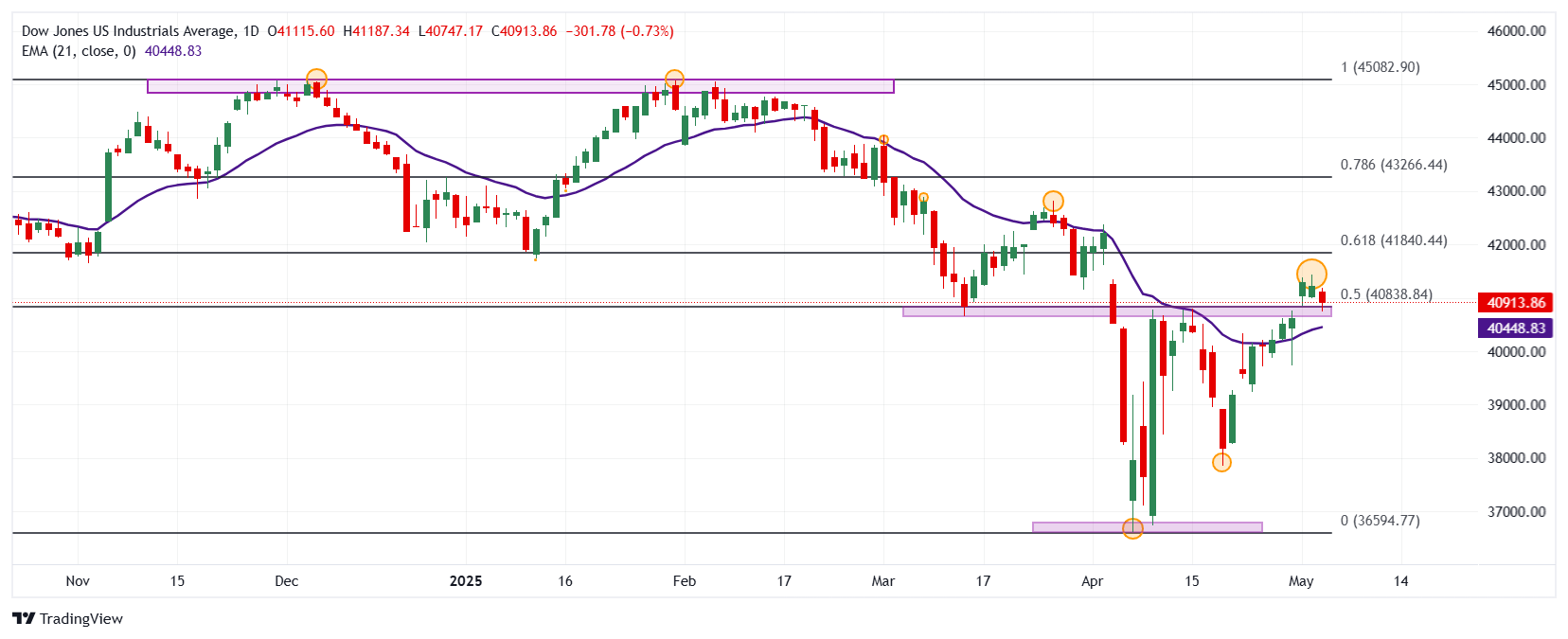- The Dow Jones decreased 098% daily, concluding the session at 40,813.
- The Nasdaq 100 loses 0.92% on Tuesday, dragged by Palantir Technologies (PLTR).
- The S&P 500 loses 0.80% in the day, spinning its second consecutive day down.
- The focus of investors will be in the decision of interest rates on the part of the Federal Reserve, the consensus expects to remain unchanged by 4.50%.
The Dow Jones established a daily maximum in 41,187, where he found aggressive vendors that dragged the index below May 2 in 40,747.
The Dow Jones industrial average began operating in 41,115, while the Nasdaq 100 technological index began negotiations in 19,921. The S&P 500 opened in 5,632, taking up the short -term bassist perspective.
The Dow Jones extends his losses weighed by Merck & Company and Amgen
The Dow Jones index falls 0.98% today, establishing a minimum of the day at 40,747.
Amgen’s titles (AMGN) lose 3.77% on the second day of the week, reaching a minimum of April 17 at 268.81, spinning four consecutive days down.
Following the bassist perspective, the shares of Merck & Company (MRK), back 4.79% in the day, visiting minimal not seen since April 25 at $ 78.76, leading losses in the share index.
The Dow Jones loses 402 points, signing its second consecutive day down, in tune with the main stock market indices.
Palantir Technologies and Vertex Pharmaceuticals lead the falls in Nasdaq 100
The Nasdaq 100 technological index loses 0.92% today, signing its second consecutive day down and reaching a minimum of two days in 19,652.
The VERTEX Pharmaceuticals (VRTX) values collapse 11.54% daily, reaching minimums not seen since January 23 at $ 428.55 after making their financial report known.
VRTX obtained income for 2.77 billion dollars compared to the 2.86 billion dollars expected by analysts, as well as an action of $ 4.06, below the 4,245 planned by the market.
In the same tonic, the actions of Palantir Technologies (PLTR) fall 12.26% in the day, reaching minimum of April 24 in 105.32 $.
PLTR published its profit report yesterday, obtaining 883.86 billion dollars of income compared to 862.17 billion dollars projected by analysts and a gain per share of 0.13 $, slightly above 0.129 estimated.
In this context, the Nasdaq 100 goes back 184 points, consolidating in minimum of May 2 in 19,782.
The S&P 500 extends its losses prior to the Federal Reserve interest rate decision
The S&P 500 falls 45 points on the day on Tuesday, quoting currently about 5,603, spinning two consecutive days down. In this sense, modern shares (MRNA) fall 10.63% reaching a minimum of April 21 in 24.16 $.
The attention of investors will be in the decision of interest rates by the Federal Reserve. The CME Fedwatch tool shows 96.9%probability of maintaining interest rates in a range between 4.25%- 4.50%.
Technical Analysis of Dow Jones
The Dow Jones formed a short -term support given by the minimum of April 21 in 37,853. The following key support is 36.614, minimum of April 7. Upwards, the key resistance is observed at 45,068, pivot point of January 31.
Dow Jones daily graphics

Dow Jones Faqs
The Dow Jones Industrial Avenge, one of the oldest stock market indexes in the world, consists of the 30 most negotiated values in the United States. The index is weighted by the price instead of capitalization. It is calculated by adding the prices of the values that compose it and dividing them by a factor, currently 0.152. The index was founded by Charles Dow, also founder of the Wall Street Journal. In recent years it has been criticized for not being sufficiently representative, since it only follows 30 companies, unlike broader rates such as S&P 500.
There are many factors that promote the Dow Jones Industrial Average (DJIA) index. The main one is the added performance of the companies that compose it, revealed in the quarterly reports of business benefits. The American and world macroeconomic data also contribute, since they influence investor confidence. The level of interest rates, set by the Federal Reserve (FED), also influences the DJia, since it affects the cost of credit, on which many companies depend largely. Therefore, inflation can be a determining factor, as well as other parameters that influence the decisions of the Federal Reserve.
Dow’s theory is a method to identify the main trend of the stock market developed by Charles Dow. A key step is to compare the direction of the Dow Jones Industrial Avenge (DJIA) and the Dow Jones Transportation Average (DJTA) and just follow the trends in which both move in the same direction. The volume is a confirmation criterion. The theory uses elements of maximum and minimum analysis. Dow’s theory raises three phases of the trend: accumulation, when intelligent money begins to buy or sell; Public participation, when the general public joins the trend; and distribution, when intelligent money abandons the trend.
There are several ways to operate with the DJ. One of them is to use ETF that allow investors to negotiate the DJ as a single value, instead of having to buy shares of the 30 companies that compose it. An outstanding example is the SPDR Dow Jones Industrial Avenge ETF (day). Future contracts on the DJ allow the specular operators about the future value of the index and the options provide the right, but not the obligation, to buy or sell the index at a predetermined price in the future. Investment funds allow investors to buy a part of a diversified portfolio of DJ values, which provides exposure to global index.
Source: Fx Street
I am Joshua Winder, a senior-level journalist and editor at World Stock Market. I specialize in covering news related to the stock market and economic trends. With more than 8 years of experience in this field, I have become an expert in financial reporting.







